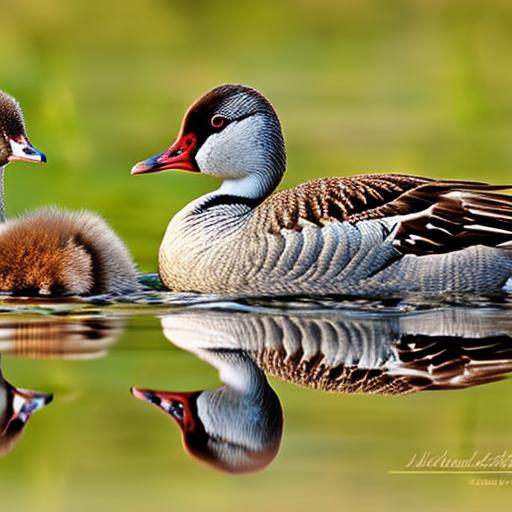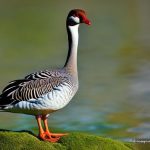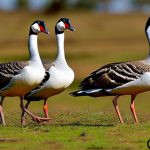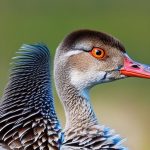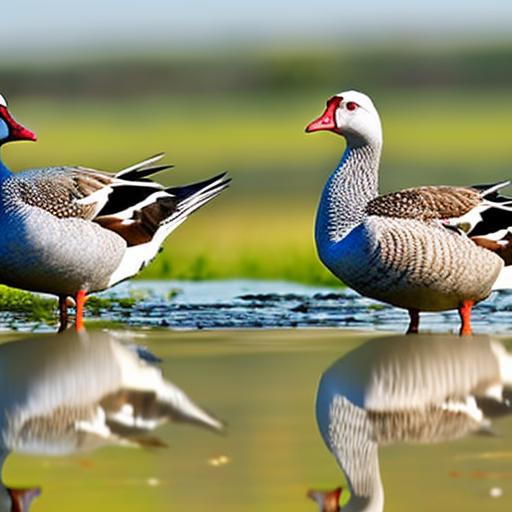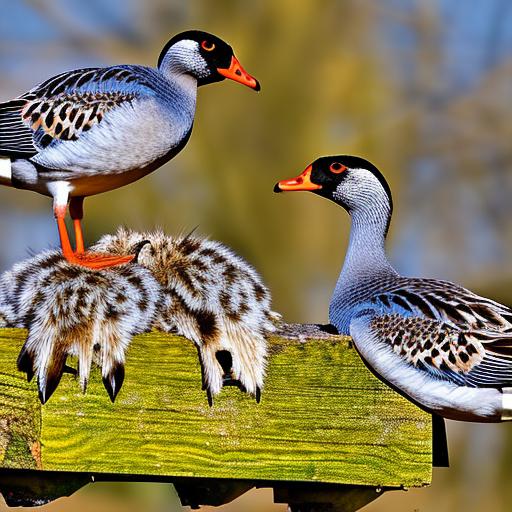Geese hybridization is a fascinating and complex phenomenon that has captured the attention of scientists, conservationists, and bird enthusiasts around the world. The process of hybridization occurs when two different species of geese interbreed, resulting in offspring that possess a unique combination of traits from both parent species. This can lead to a wide range of physical and behavioral characteristics, making hybrid geese a subject of great interest and study.
Hybrid geese can be found in various habitats, from urban parks and suburban neighborhoods to remote wilderness areas. Their adaptability and resilience have allowed them to thrive in diverse environments, making them a truly remarkable example of evolutionary success. The study of geese hybridization offers valuable insights into the mechanisms of speciation, adaptation, and genetic diversity, shedding light on the intricate processes that drive the evolution of life on Earth.
The History and Origins of Geese Hybridization
The history of geese hybridization dates back thousands of years, with evidence of hybrid offspring being documented in ancient texts and artwork. In many cultures, hybrid geese were revered for their unique beauty and symbolism, often depicted in religious ceremonies and folklore. The origins of geese hybridization can be traced to the natural intermingling of different species in the wild, as well as human intervention through domestication and selective breeding.
In more recent history, the deliberate crossbreeding of geese species has been carried out by breeders and enthusiasts seeking to create new varieties with desirable traits such as size, coloration, and temperament. This has led to the development of numerous hybrid goose breeds that are valued for their ornamental and practical purposes, contributing to the rich tapestry of avian diversity that exists today. The legacy of geese hybridization continues to shape our understanding of genetics and evolution, offering a window into the dynamic interplay between different species and their environments.
The Science Behind Geese Hybridization
The process of geese hybridization is governed by a complex interplay of genetic, ecological, and behavioral factors that influence the likelihood and outcomes of interbreeding between different species. At the genetic level, hybridization can result in the mixing and reshuffling of genetic material from parent species, leading to the creation of novel gene combinations in the offspring. This genetic diversity can confer advantages such as increased adaptability, disease resistance, and reproductive success, allowing hybrid geese to thrive in a wide range of environments.
Ecological factors such as habitat overlap, population density, and resource availability can also play a significant role in facilitating or inhibiting geese hybridization. In some cases, environmental changes or human activities may create opportunities for different species to come into contact and interbreed, leading to the formation of hybrid populations with unique ecological niches. Behavioral interactions between parent species, such as courtship displays, mate choice, and territorial behavior, can further influence the dynamics of hybridization and shape the genetic composition of future generations.
The Impact of Geese Hybridization on Conservation Efforts
The impact of geese hybridization on conservation efforts is a topic of ongoing debate and research within the scientific community. On one hand, hybridization can lead to the loss of genetic purity and distinctiveness in wild populations, potentially eroding the unique adaptations and evolutionary history of individual species. This has raised concerns about the potential homogenization of gene pools and the loss of biodiversity, particularly in cases where rare or endangered species are at risk of hybridizing with more common or invasive species.
On the other hand, some researchers argue that hybridization can contribute to the resilience and adaptive potential of geese populations, allowing them to respond more effectively to environmental changes and human disturbances. Hybrid individuals may possess a broader range of genetic traits that enable them to thrive in novel or challenging conditions, providing a source of genetic variation that can enhance the long-term survival prospects of wild populations. This perspective has led to calls for a more nuanced approach to managing hybridization in conservation settings, recognizing both the risks and potential benefits that it may entail.
The Challenges and Controversies Surrounding Geese Hybridization
The study and management of geese hybridization present a number of challenges and controversies that reflect the complex nature of this phenomenon. One major challenge is the difficulty of accurately identifying and classifying hybrid individuals in the wild, particularly when they exhibit intermediate or mixed traits that blur the boundaries between different species. This can complicate efforts to monitor and assess the extent of hybridization within wild populations, making it challenging to develop effective conservation strategies that account for the presence of hybrid individuals.
Controversies surrounding geese hybridization also stem from differing perspectives on the value and implications of hybridization for wild populations. Some conservationists advocate for strict measures to prevent or mitigate hybridization in order to preserve the genetic integrity of native species and maintain their evolutionary distinctiveness. Others argue that hybridization is a natural process that has been occurring for millennia, and that attempts to suppress or eliminate it may be misguided or counterproductive. Finding common ground between these viewpoints is essential for developing evidence-based approaches to managing geese hybridization that balance ecological integrity with practical considerations.
Breeding Beyond Borders: Geese Hybridization in the Modern World
In the modern world, geese hybridization continues to be shaped by a diverse array of human activities and influences that extend beyond natural ecological processes. The global trade and transportation of domesticated geese breeds has facilitated the spread of hybrid individuals into new regions, where they may come into contact with native species and potentially interbreed with them. This has raised concerns about the potential for genetic introgression and disruption of local gene pools, particularly in cases where introduced hybrids may outcompete or interbreed with native species.
At the same time, advances in breeding techniques and genetic technologies have opened up new possibilities for creating and managing hybrid goose populations for agricultural, ornamental, and conservation purposes. Breeders and conservationists are exploring innovative approaches to selectively breed and manage hybrid geese with specific traits or adaptations that are valuable for various purposes, such as meat production, egg laying, pest control, or ecological restoration. These efforts highlight the potential for harnessing the power of geese hybridization in ways that align with human needs while also respecting the ecological integrity of wild populations.
The Future of Geese Hybridization: Opportunities and Risks
As we look to the future, the study and management of geese hybridization present both opportunities and risks that will shape our understanding and stewardship of avian biodiversity. Advances in genomic research and molecular ecology are providing new tools for investigating the genetic basis of hybridization and its ecological consequences, offering insights into the mechanisms that drive evolutionary change in geese populations. This knowledge can inform more targeted conservation strategies that account for the dynamic nature of hybridization and its potential impacts on wild populations.
At the same time, ongoing human activities such as habitat destruction, climate change, and invasive species introductions are creating novel challenges for managing geese hybridization in a rapidly changing world. These pressures may exacerbate existing patterns of hybridization or create new opportunities for different species to come into contact and interbreed, leading to unpredictable outcomes for wild populations. Addressing these challenges will require a coordinated effort involving scientists, policymakers, land managers, and local communities to develop adaptive strategies that promote the long-term resilience and sustainability of geese populations in a dynamic and interconnected world.
In conclusion, geese hybridization represents a complex and dynamic process that reflects the intricate interplay between genetic, ecological, and human factors shaping avian biodiversity. By studying and understanding this phenomenon, we can gain valuable insights into the mechanisms driving evolutionary change in geese populations, as well as develop more effective strategies for conserving their genetic diversity and ecological integrity. Embracing a holistic approach that recognizes both the challenges and opportunities presented by geese hybridization will be essential for ensuring the long-term survival and well-being of these remarkable birds in an ever-changing world.
Meet Walter, the feathered-friend fanatic of Florida! Nestled in the sunshine state, Walter struts through life with his feathered companions, clucking his way to happiness. With a coop that’s fancier than a five-star hotel, he’s the Don Juan of the chicken world. When he’s not teaching his hens to do the cha-cha, you’ll find him in a heated debate with his prized rooster, Sir Clucks-a-Lot. Walter’s poultry passion is no yolk; he’s the sunny-side-up guy you never knew you needed in your flock of friends!

